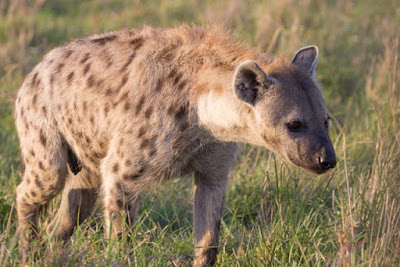 |
| PC Lily J-U |
Especially in times of the year when prey is abundant, it seems like everyone in the clan should always be able to find a suitable meal at any time of the day. However, hyenas in hunting mode constantly assess their environment and, unless a better opportunity arises, will consistently hunt in conditions which render prey species most compromised. For example, spotted hyenas are primarily crepuscular, and will take advantage of their superior eyesight in low-light to no-light periods of the day to more easily overcome prey. In addition, the landscape type is chosen specifically to match the preferred hunting style of hyenas. Spotted hyenas often prefer to hunt in open plains to areas with denser vegetation because it affords them higher visibility and more room to either maneuver as a group or run down prey using their exceptional endurance. Some hyenas have even been known to take advantage of terrain and weather conditions and will actually preferentially hunt in wet and stormy conditions because prey can be rendered more vulnerable during these times.
 |
| PC Lily J-U |
Like many other carnivores which make the Mara their home, prey choice is an important part of the hunt. Hyenas will engage in a behavior called "test chasing" as a means of assessing the availability of prey within any one herd of ungulates. The age and weakness of each individual in the herd is assessed based on their ability to run away from the pursuing hyenas. If no individual is determined to be a suitable candidate for the hunt, then the hyenas will simply give up the chase and look to another herd. However, if one is found which can be separated from the group, the hunters will quickly do so and take it down within minutes. Opportunism is a large part in what makes hyenas excellent hunters. Due to the large fluctuations in the composition of prey over the course of the year, one will also see similar changes reflected in the proportions of different prey species hunted. While our Mara hyenas certainly have their preferences in prey (zebra happen to be one of their favorites when they can get it), they will eat pretty much any herbivore found in the Mara in proportions which roughly reflect the ease at which they can acquire it at any one point in the year.
 |
| PC Lily J-U |
Among the most interesting and useful tools in a spotted hyena's repertoire is the variety of vocalizations they use in different phases of the hunt. Among the most famed, and incidentally the most versatile, is the classic whoop. While often used for long distance communication (e.g. in alerting other members of the clan kilometers away to one's presence), this call can be used in the short range as an indication of alarm. In these instances, individuals will use a shorter, higher frequency series of calls than the classic long and low variety. For lower ranking hyenas, whooping can also be a powerful deceptive device. It is not uncommon to see an immigrant males and other low ranking hyenas stand off to the side of a carcass and whoop for the attention of the rest of the clan (a favorite tactic of our very own immigrant male Roswell, I might add). This causes the higher ranked hyenas feeding to pause and scan the area for danger, allowing our whooper to sneak in and steal some food for a few seconds before he is caught!
The alarm rumble, a low staccato sound, can be used in the same manner, although this vocalization is more often used as an indication of a sighting of real danger. The first individual to see the imminent approach of a lion, human, or some other danger which could attempt to steal food or otherwise interrupt feeding will vocalize in an attempt to mobilize the entire group. In this way, every individual present at the carcass has an immediate cue to alert and cooperate in the defense of their prey.
 |
| PC Lily J-U |
To be continued...





















